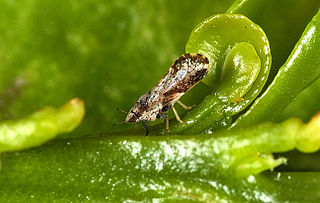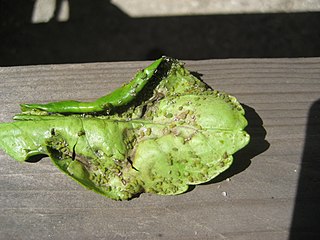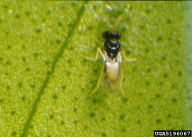
Citrus is a genus of flowering trees and shrubs in the family Rutaceae. Plants in the genus produce citrus fruits, including important crops such as oranges, mandarins, lemons, grapefruits, pomelos, and limes.

Citrus production encompasses the production of citrus fruit, which are the highest-value fruit crop in terms of international trade. There are two main markets for citrus fruit:

Psyllidae, the jumping plant lice or psyllids, are a family of small plant-feeding insects that tend to be very host-specific, i.e. each plant-louse species only feeds on one plant species (monophagous) or feeds on a few closely related plants (oligophagous). Together with aphids, phylloxerans, scale insects and whiteflies, they form the group called Sternorrhyncha, which is considered to be the most "primitive" group within the true bugs (Hemiptera). They have traditionally been considered a single family, Psyllidae, but recent classifications divide the group into a total of seven families; the present restricted definition still includes more than 70 genera in the Psyllidae. Psyllid fossils have been found from the Early Permian before the flowering plants evolved. The explosive diversification of the flowering plants in the Cretaceous was paralleled by a massive diversification of associated insects, and many of the morphological and metabolic characters that the flowering plants exhibit may have evolved as defenses against herbivorous insects.

Citrus canker is a disease affecting Citrus species caused by the bacterium Xanthomonas. Infection causes lesions on the leaves, stems, and fruit of citrus trees, including lime, oranges, and grapefruit. While not harmful to humans, canker significantly affects the vitality of citrus trees, causing leaves and fruit to drop prematurely; a fruit infected with canker is safe to eat, but too unsightly to be sold. Citrus canker is mainly a leaf-spotting and rind-blemishing disease, but when conditions are highly favorable, it can cause defoliation, shoot dieback, and fruit drop.

The orange, also called sweet orange to distinguish it from the bitter orange, is the fruit of a tree in the family Rutaceae. Botanically, this is the hybrid Citrus × sinensis, between the pomelo and the mandarin orange. The chloroplast genome, and therefore the maternal line, is that of pomelo. There are many related hybrids including of mandarins and sweet orange. The sweet orange has had its full genome sequenced.
Citrus tristeza virus (CTV) is a viral species of the genus Closterovirus that causes the most economically damaging disease to its namesake plant genus, Citrus. The disease has led to the death of millions of Citrus trees all over the world and has rendered millions of others useless for production. Farmers in Brazil and other South American countries gave it the name "tristeza", meaning sadness in Portuguese and Spanish, referring to the devastation produced by the disease in the 1930s. The virus is transmitted most efficiently by the brown citrus aphid.

Murraya paniculata, commonly known as orange jasmine, orange jessamine, china box or mock orange, is a species of shrub or small tree in the family Rutaceae and is native to South Asia, Southeast Asia and Australia. It has smooth bark, pinnate leaves with up to seven egg-shaped to elliptical leaflets, fragrant white or cream-coloured flowers and oval, orange-red berries containing hairy seeds.

Brachygastra mellifica, commonly known as the Mexican honey wasp, is a neotropical social wasp. It can be found in North America. B. mellifica is one of few wasp species that produces honey. It is also considered a delicacy in some cultures in Mexico. This wasp species is of use to humans because it can be used to control pest species and to pollinate avocados.
Psyllid yellows is a disease of potatoes infested by the potato/tomato psyllid, Bactericera cockerelli. The symptoms are a marked yellowing of the leaves, an upright appearance to the leaves, with severe cases resulting in early death of the plant. Tuber initiation and growth is affected. Many small tubers are formed, frequently misshaped. In some cases, the tubers seem to have lost sprouting inhibition and have begun sprouting before harvest. At later stages, the tubers sprout weakly, if at all.

Zebra chip, also known as papa manchada and papa rayada, is a disease in potatoes putatively caused by an alphaproteobacterium "Candidatus Liberibacter solanacearum", which is vectored by the potato psyllid. When fried, potato tubers from infected plants develop unsightly black lines resembling the stripes of zebras that render the chips unsellable. Additionally, striped sections of chips frequently burn and caramelize, resulting in a bitter flavor. No health risks have been connected with consumption of infected potato chips.

Diaphorina citri, the Asian citrus psyllid, is a sap-sucking, hemipteran bug now in the taxonomic family Psyllidae. It is one of two confirmed vectors of citrus greening disease. It has a wide distribution in southern Asia and has spread to other citrus growing regions.

Trioza erytreae, the African citrus psyllid, is a sap-sucking insect, a hemipteran bug in the family Triozidae. It is an important pest of citrus, being one of only two known vectors of the serious citrus disease, huanglongbing or citrus greening disease. It is widely distributed in Africa. The other vector is the Asian citrus psyllid, Diaphorina citri.

Liberibacter is a genus of Gram-negative bacteria in the Rhizobiaceae family. Detection of the liberibacteria is based on PCR amplification of their 16S rRNA gene with specific primers. Members of the genus are plant pathogens mostly transmitted by psyllids. The genus was originally spelled Liberobacter.

Planococcus citri, commonly known as the citrus mealybug, is a species of mealybugs native to Asia. It has been introduced to the rest of the world, including Europe, the Americas, and Oceania, as an agricultural pest. It is associated with citrus, but it attacks a wide range of crop plants, ornamental plants, and wild flora.
Spiroplasma citri is a bacterium species and the causative agent of Citrus stubborn disease.
The Citrus stubborn disease is a plant disease affecting species in the genus Citrus. The causative agent of the agent of the disease is Spiroplasma citri, a Mollicute bacterium species. The bacterium resides in the phloem of the affected plant. Originally discovered in citrus-growing regions of California, S. citri is transmitted by several leafhoppers, including Circulifer tenellus and Scaphytopius nitridus in citrus-growing regions of California. The disease has now spread to Arizona by the same hoppers, and Circulifer haematoceps in the Mediterranean region.

Cyantraniliprole is an insecticide of the ryanoid class, specifically a diamide insecticide. It is approved for use in the United States, Canada, China, and India. Because of its uncommon mechanism of action as a ryanoid, it has activity against pests such as Diaphorina citri that have developed resistance to other classes of insecticides.

Tamarixia radiata, the Asian citrus psyllid parasitoid, is a parasitoid wasp from the family Eulophidae which was discovered in the 1920s in the area of northwestern India (Punjab), now Pakistan. It is a parasitoid of the Asian citrus psyllid, an economically important pest of citrus crops around the world and a vector for Citrus greening disease.
Mark L. Nelson is an American chemist specializing in the field of antibiotics and tetracyclines. His synthesis techniques have resulted in over 40 patents and he conceived and synthesized with Mohamed Ismail along with Laura Honeyman and Kwasi Ohemeng, the tetracycline antibiotic Omadacycline (Nuzyra), the first of the Aminomethylcycline subclass of tetracyclines to reach medical use. Nuzyra is useful against resistant bacteria and used for severe cases of skin infections, ABSSSIs, Community Acquired Pneumonia (CABP) and nontuberculosis mycobacteria. Nuzyra also has demonstrated activity against Anthrax, and was purchased by the US government under a BARDA contract for Project Bio-shield to treat anthrax exposure, and is now in the Strategic National Stockpile in the US in case of a bioterrorism attack. Nuzyra was also approved for use against the Plague, caused by Yersinia pestis infections.
















